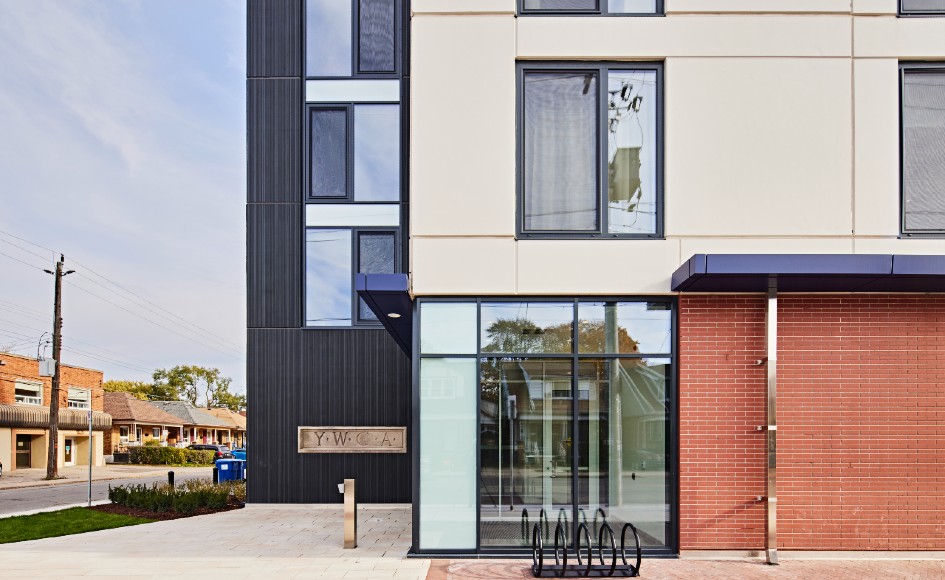A new men’s emergency and transitional housing facility, set to rise in Aurora, Ontario, has opened the door to pilot-testing Passive House “as one of the most efficient uses of public funds for housing,” according to Melissa McEnroe, manager of affordable housing for York Region.
“It has been our aspirational goal for the past five years,” says McEnroe. “But only recently have we had the local capacity to design and build it.”
Passive House is a voluntary standard for achieving extremely energy-efficient buildings. Known as a “factor-10 house,” it uses one-tenth of the energy of an average building; it is so efficient that residents’ bodies and the sun act as heat sources. This is the result of a super-insulated envelope with an R-factor almost 100 per cent greater than a standard build. The entire building is sealed airtight, and the triple-glazed windows are warm to the touch. A Passive House keeps the heat in.
“The space heating demand is equivalent to heating your home with the light of one candle,” says Deborah Byrne, COO and director of Passive House Design at Kearns Mancini Architects (KMAI)—the firm designing the project.
Passive House buildings are also praised for their higher level of comfort.
“This is healthy housing; the building provides constant fresh air,” says Byrne. “It is comfortable housing with wellness built in; there is little or no active heating or cooling. With constant low-flow ventilation and with constant air and surface temperature, there are no drafts or cold spots.”
Ventilation is also the new code word for COVID-19 prevention. Old-style multi-unit buildings are synonymous with stale air—the air return being sucked down the hallway, along with the odours of everyone’s supper. With Passive House, every room has filtered, fresh air, which is offset by efficient stale air extraction, providing an energy balance.
“You feel it immediately when you walk into the Putman Family YWCA,” agrees Medora Uppal, director of operations at the Hamilton YWCA. “The air; it feels clean and refreshing. And it is silent—so quiet, even on busy Ottawa Street.”
Uppal shepherded the development of the new social housing residence, which opened last September as a five-storey Passive House facility, also designed by KMAI. The massiveness of the walls (and no air leakage) attenuates sounds and provides a calm feeling throughout. The facility is an oasis that’s well-suited to help heal those who seek refuge there.
“There’s clearly an environmental benefit,” she adds. “But it also makes good business sense. It is the least expensive sustainable solution. When it comes to green energy solutions, Passive House is the only way to go.”

The Putman Family YWCA in Hamilton, Ontario, opened its doors in September 2021. Photo by Industryous.
Tapping into affordability
York Region is forward-looking in sustainable building practices, but in the end, it still comes down to money. “All utilities are paid by York Region,” says McEnroe. “Passive House is in our best interest for cost recovery.”
In the case of the Putman Family YWCA, the facility cost only two per cent more to build, compared to code construction, and saves up to 90 per cent in ongoing thermal energy costs. With this formula, the slight additional capital costs will be paid back in two years.
McEnroe is keen on pursuing the standard much further. “Passive House is now a reasonable option. Skill levels are starting to catch up. There is a maturity to the sector, which is now available to those who are seeking Passive House,” she says.
“Also, we have local options in modular builds with prefabricated panels. To meet the terms of the rapid-housing initiative and other quick-start funding opportunities, we need not only the money, but the professional skills, materials, and supply solutions at the local level.”
Funding from the Canada Mortgage and Housing Corporation (CMHC) also helps with the extra costs of Passive House. As McEnroe says, “CMHC is definitely increasing their attention to sustainable features.”
The cost effectiveness of modular building makes it easier to pursue Passive House in York Region.
At KMAI, where Passive House design is insourced, the team has developed expertise in modifying existing modular panels to achieve International Passive House Standards. The firm co-developed the prefabricated highly insulated concrete modules for the Putman Family YWCA and worked with a manufacturer to develop a modular steel wall system for an affordable housing project in Windsor, Ont., which is now the first certified Passive House wall component in Canada.
McEnroe believes that the skills set and new materials are a direct result of the market investment. “The desire is here. That’s what is driving the market. The systems being put in place to build long-term, sustainable affordable housing are requiring this,” she says.
“Like any developer, we need to quantify the risk. If the products and materials are made here, and if it’s reliably available for delivery on-site, then it becomes much more developer friendly. Available and sustainable, that’s the key. Knowing the risks in construction allows us to quantify the risks early on and make better decisions for the project’s success.”
Public funds for public good
At the same time, McEnroe does not want to sacrifice liveability for economic sustainability. “Passive House just feels different,” she says. “It feels more still. Institutional settings like long-term care or emergency and transitional housing are a perfect application, where each room is separately ventilated and climate controlled, and utility costs are centralized.”
As infection control figures prominently into the new men’s facility, planned for completion in 2024, Passive House airflow will help make the building as disease resilient as housing can be and, also, maybe pandemic proof.
The airtight envelope controls all the air coming in and out of the building. The ventilation systems are equipped with hospital-grade filters, which remove 99 per cent of known pathogens and toxins. Passive House can optimize the relative humidity in the building as it offers optimal conditions for the human body to fight off any potential airborne disease.
Healing will be an integral concept to this refuge for adult men experiencing or at risk of homelessness.
“York hired a consultant to recommend the location of the building,” says Jonathan Kearns, CEO and principal in charge of KMAI. “They recommended the south side, but our concept was for the north where it connected with a wooded area and had a warm southern exposure. Here, the men could walk out into the trees, find some peace and have a forest bath as it were to help them heal.”
“This project is just good all around,” adds McEnroe. “The social good of 30,000 square feet of homes and services for men at high risk. The environmental good of using public money for a Passive House design – engaging local talent to grow the segment and provide an example of how to move forward. It’s a great example of efficiently using public funds for the most public good.”
She wonders, though, what the market will attract. Passive House is beneficial to people who are in crisis during transition; however, Housing York Inc.’s newest affordable housing communities are typically around 70 per cent subsidized and 30 per cent market apartments, meaning 30 per cent of new residents will be choosing a new building from amongst all the private market rental options available to them. How might Passive House suit those residents?
Through conversations with housing corporations and people who lived and grew up in social housing, KMAI has gathered more understanding of how Passive House responds to the issues inherent in typical affordable housing, such as inadequate funding and poor maintenance.
Residents are often unable to live in the entire space in winter or summer because of mould, dampness and condensation, and the effects of this type of housing on someone’s physical and mental health and on a person’s self-esteem can be dire.
As the industry works to find that happy medium where affordability and livability thrive, where healthy, low-energy buildings help mitigate the social and environmental problems communities are facing, Passive House offers a path forward.
The design concepts for Passive House started in Canada with the Saskatchewan House in 1977, were refined by German physicists over 20 years ago, became recognized by the Intergovernmental Panel on Climate Change as the standard for climate-resilient housing, and have made their way back home, with many projects currently in the pipeline from coast to coast. Now, this new era of construction has finally made its way to York Region.
John Gregory is a Toronto-based freelance writer. He runs an educational communications firm with his partner, Marcia Cunningham (www.cgced.com). They have worked extensively on environmental issues: energy conservation, electric vehicles, renewable energy, climate change and resilient, liveable cities. John and Marcia are also communicating the necessary role of the aggregate industry and are principals in the challenge of youth envisioning their city in 10 years. www.mytoin10.org.






